This post may contain affiliate links. For more information, read my disclosure policy.
If you want to bake like a pro, you don’t need a kitchen full of baking tools to do it! I’m sharing five essential baking tools that every home baker should have. They are the tools I use over and over again and would be lost without. If you want to make baking easier and your recipes even better, this post is for you!
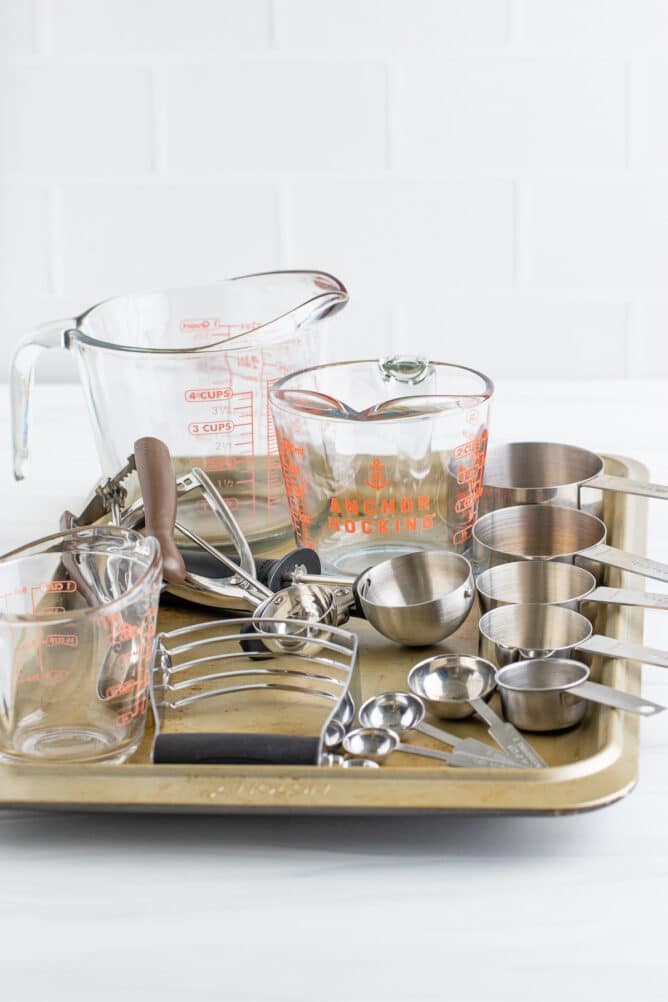
Half of the challenge with baking is having the right baking tools on hand, and you probably already know there are a lot of baking accessories. I hear from new bakers all the time asking about the tools I have in my kitchen, so I thought I would write a post about it!
The great news? You don’t need to spend a ton of money or stuff your cabinets full of tools to bake a variety of recipes. I think there are just five kitchen baking tools every baker should have on hand. I’m also sharing my tips for how to clean and store baking tools and equipment.
Must Have Baking Tools
It might seem short but having these five things means you can make a ton of different recipes:
- Measuring cups (wet and dry)
- Measuring spoons
- Cookie scoops
- Pastry cutter
- Scale
Whether you’re a seasoned baker or new to baking, having these baking tools on hand makes life in the kitchen so much easier. So, let’s dive in!
Table of Contents
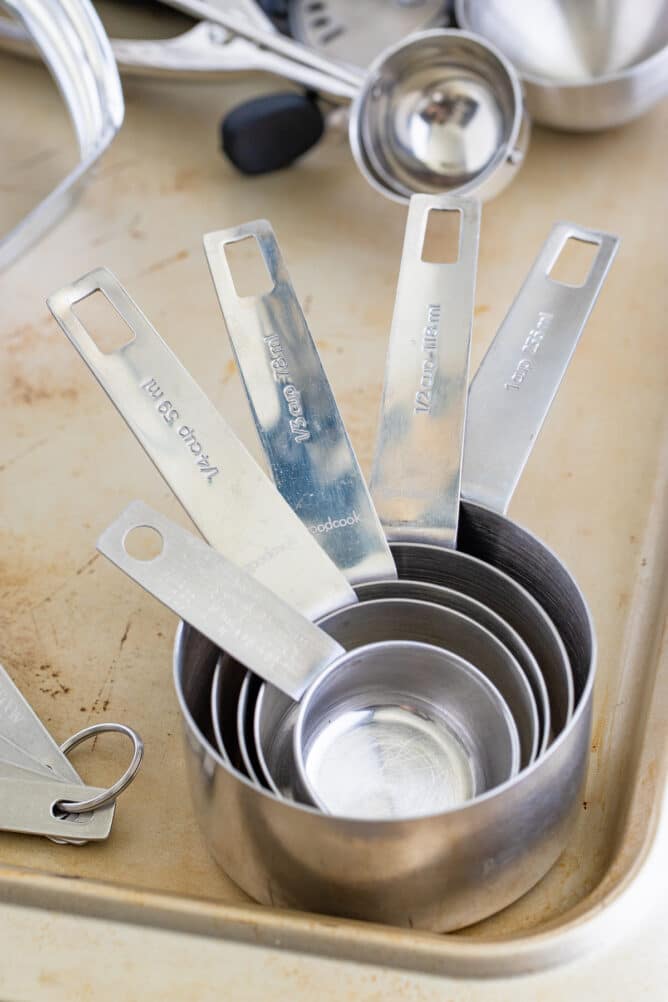
Measuring Cups
There are two kinds of measuring cups: liquid and dry. They are not interchangeable, and it’s essential to have both so you can accurately measure ingredients.
This is especially important in baking, where precise measuring can make a huge difference in your final dessert. Adding too much or too little of an ingredient is less forgiving in baking than savory cooking, where it’s not always critical.
Dry measuring cups are used for, well, dry ingredients! Flour, sugar, breadcrumbs, cocoa powder, nuts… basically anything that is not a liquid. This kind of measuring cup makes measuring dry ingredients easier because you can fill the cup and then level it off to get an exact measurement.
Liquid measuring cups are for, you guessed it, anything wet. Water, milk, and cream are the obvious ones, but things like honey and molasses. These types of measuring cups have lines marking the amounts and a spout making it easy to pour.
One question I get a lot is, “but don’t they measure the same amounts?” Or, in another way, is one cup in a dry measuring cup the same amount as one cup liquid? The technical answer is, yes, they are the same. But if you’ve ever filled a one cup dry measuring cup to the brim with water, you know it’s a challenge getting all of it into the bowl without it sloshing over the sides.
The same is for using a liquid measuring cup to measure flour. To get it level, you would have to tap the bottom of the cup for the flour to even out. This tamps it down, compacting it so you would end up with too much flour. That’s why the spoon and level method using a dry measuring cup is the best way to do it.
So, to improve accuracy in measuring, use them for their intended purpose. Your baking projects will thank you for it! If you’re looking for more background information on the differences, this post is for you!
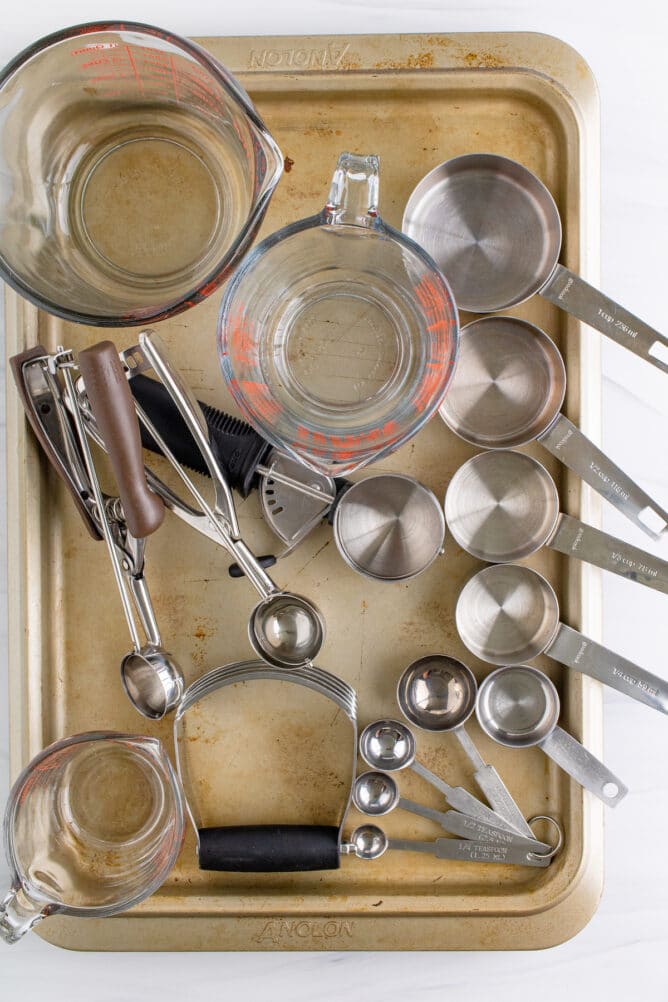
Measuring Spoons
Measuring spoons allow you to measure small amounts of ingredients, both liquid and dry. I recommend having two sets of measuring spoons.
If you measure both wet and dry ingredients, you can use one set for each – that way, you don’t have to stop to wash the spoons while you’re making a recipe.
Another tip is to avoid buying measuring spoons with writing on them that can rub off. There’s nothing worse than trying to figure out which one is which if you can’t read the marking. Look for metal ones that have the measurement etched in. They will last for years!
Storage tips for cups and spoons: I have a designated drawer for my measuring cups and spoons. I keep the cups nested, so they are easy to grab all at once. For the spoons, I use dividers and keep the same sized ones together.
SAVE THIS RECIPE
Cleaning tip for cups and spoons: To prolong the life of my measuring spoons and measuring cups, I usually wash them by hand in hot soapy water. I’ve had plenty of measuring tools get mangled and damaged in the dishwasher!
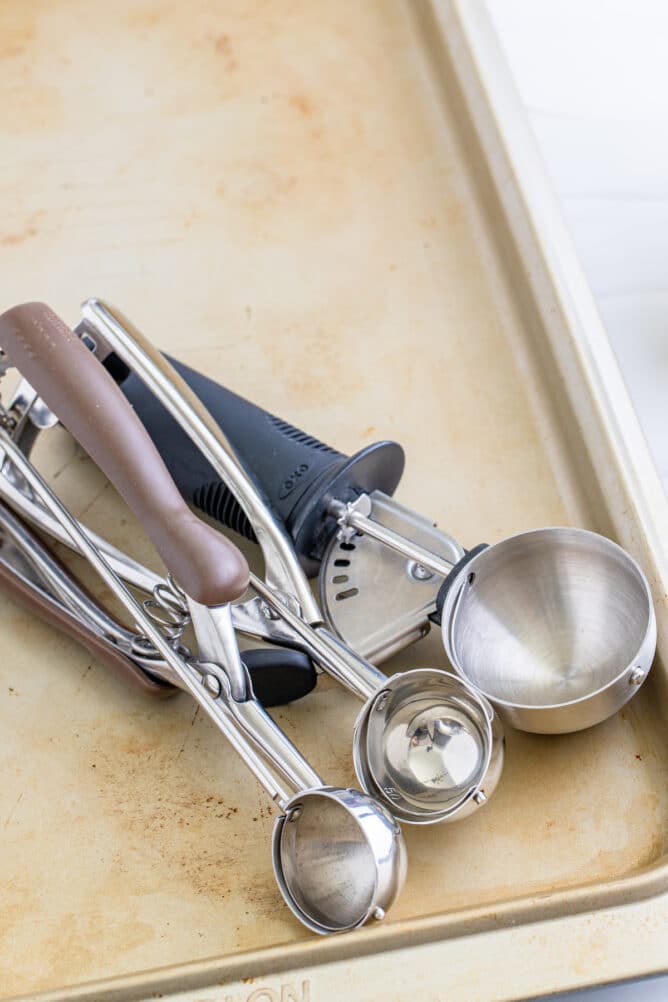
Cookie Scoops
These are among my most favorite baking tools! Cookie scoops make everything so much easier when making cookie dough balls or transferring batter from a bowl to a muffin tin.
Similar to measuring spoons, they come in a variety of sizes. What makes them so great is that they are spring-loaded, which means you can scoop dough and easily release it. They also act as a measuring device to scoop the same amount of dough or batter each time.
I have three: a large scoop, a medium-sized one, and a small one. The large one is great for scooping batter for muffins and cupcakes. The medium and small ones are great for scooping cookie dough, so your cookies end up the same size.
Storage tip: I keep all of my scoops in a drawer with my measuring cups and spoons. I have a drawer divider to keep them separate from the cups and spoons, so they’re easy to see and grab.
Cleaning tip: You can clean them in a dishwasher or by hand with hot soapy water!
Once you buy a set, you’ll find all kinds of ways to use them – including scooping ice cream! That might be one of my favorites.
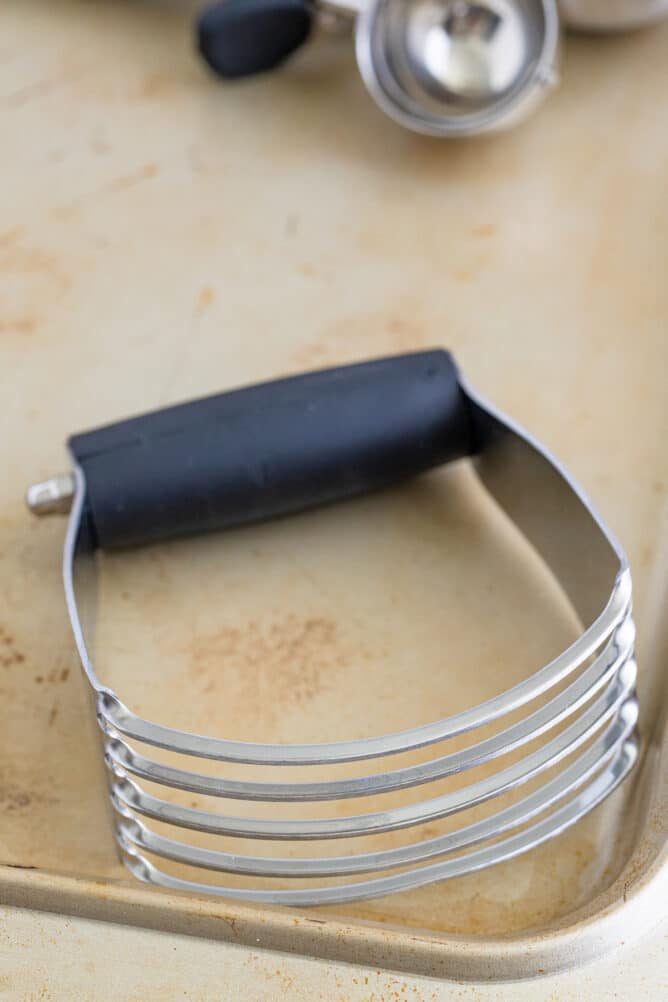
Pastry Cutter
If you want to make flaky biscuits, pie crusts, or other pastries, you definitely want to have a pastry cutter. This baking tool allows you to cut butter, shortening, or other solid fats into flour. This method of incorporating fat into flour is what creates a light and flaky pastry dough.
The cutter is designed to be held so you can do a rocking motion as you cut in the butter. This breaks the butter down into crumbles, which is the texture you want in a flaky biscuit or pastry dough. The great news is that this is an expensive tool that doesn’t take up a lot of space.
Storage tip: You will want to keep it in a spot where it can’t get tangled up with other tools, so the metal parts don’t get damaged. You can designate a place in a drawer, or you can hang it.
Cleaning tip: I recommend washing it by hand. Putting it in the dishwasher can damage and mangle the metal parts.
If you’ve struggled with making pastry because you’ve tried cutting in butter with a fork or your hands, a pastry cutter will make your life (and your baked good!) so much better.
Scale
Last but not least, I recommend owning a kitchen scale. If you want the most precise measurements, it’s the only way to go! Yes, you can use measuring cups, but a scale is even more accurate and leaves less to chance. Plus, using one means fewer dishes because you won’t have all the measuring cups to clean up.
Professional bakers rely on a scale, and once I started using one, I could tell the difference in my recipes, especially for measuring flour. Too much or too little can drastically change the texture of cookies, cakes, and other desserts. With a scale, you don’t have to worry about over or under measuring.
You can use it for other non-baking things, too! I use it to measure pasta, cuts of meat, and other ingredients that are measured in ounces and pounds instead of cups.
Here in the US, we LOVE our measuring cups, but you can’t beat the kitchen scale to measure things accurately. You don’t have to spend a lot of money, either. You can get a good quality digital scale for less than $30. Trust me – it’s worth it!
Storage tip: I keep my scale on the counter for easy access. If you want to store yours, be sure to keep it in a drawer or cabinet with nothing sitting on top of it. It should have its own space.
Cleaning tip: The best way to keep it clean is to wipe it done with a warm damp rag. You can add a little dish soap to disinfect the surface if needed. If your scale has a removable bowl, you can clean it separately with hot soapy water.
In fact, I’m such an advocate I’ll be sharing a post soon with even more reasons to treat yourself to this fantastic kitchen baking tool. So, stay tuned for that! I hope you’ve found this post helpful! If you’ve been overwhelmed about all the baking tools out there in the world, I hope this list has helped narrow down the essentials every baker should have. They will be your new baking best friends!
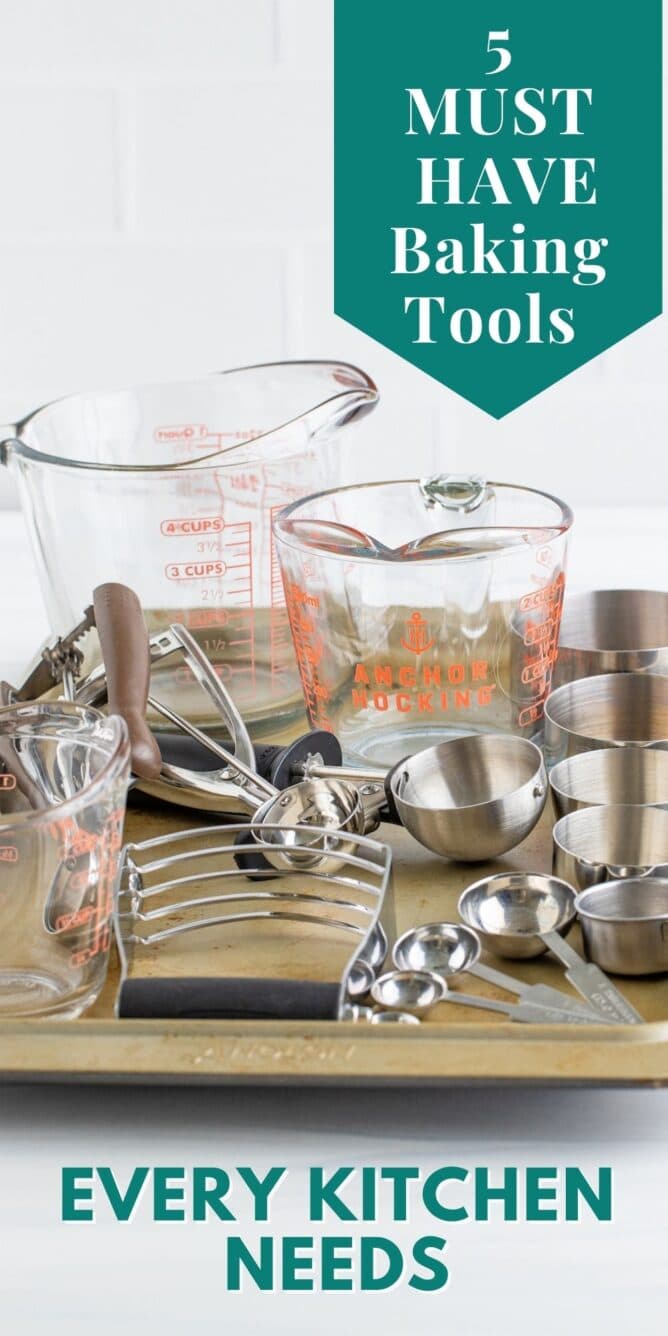
Believe it or not, you don’t need a kitchen full of fancy baking tools to bake like a pro. I’m going to show you the five essential baking tools that every home baker should have.
Have you made this recipe?
Tag @crazyforcrust on Instagram or hashtag it #crazyforcrust
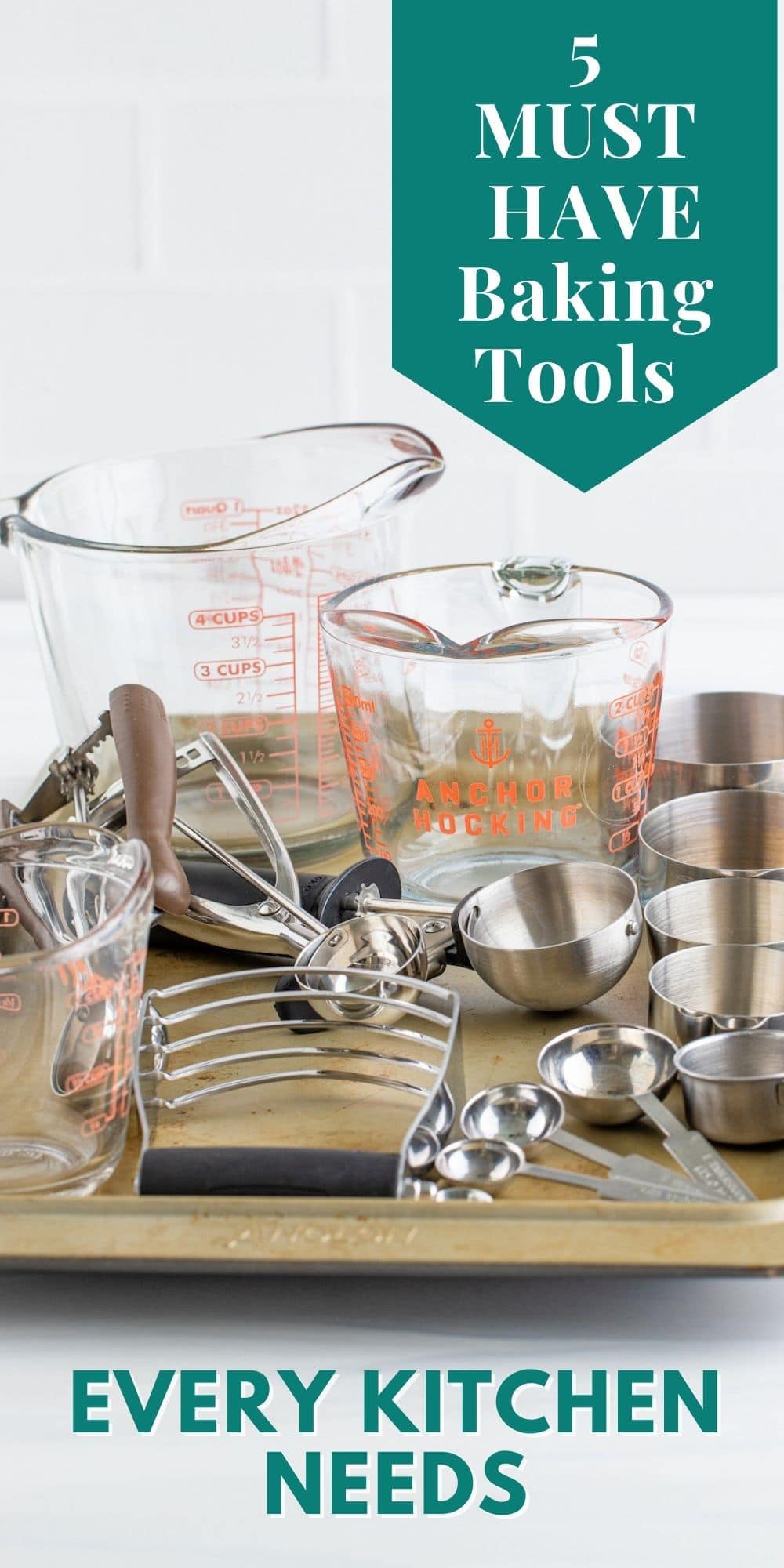
Have you ever had problems with the red lettering coming off the glass measuring cups? My largest and oldest 4 cup one is still going strong but a 2 cup and a 1 cup I bought a few years ago, couple trips through the dishwasher and all the lettering is gone which renders them useless for measuring.
If you use them in the dishwasher they will wash off
I have them. Let me say that I’m 84 and my eyesight in my one good eye isn’t very good so I need to tell the world about my pet peeve. So many things have arrows, numbers, writing on them in the same color as the item, but just embossed. I CAN’T see them unless I go put them under a special lamp I have that is a strong light plus magnification. Would it be that hard to put a black or dark blue or brown arrow or writing on something??? I found the perfect measuring cups where each cup has the fraction or number 1 on it in black. The cups are white and they aren’t straight up and down – they are like mini bowls so with a spatula I just scoop out shortening or other sticky ingredients with one swish. My measuring spoons are stainless steel and long and rectangular so they fit down into a spice jar easily. I swear that men do all of the engineering of all of these items. Oh and my wet measuring pitchers are both plastic and glass. I have one set of 3 plastic where I just set them on the counter and look down as I pour and can see just where my stop point is located. I have a set of 2 glass ones required for melting things in the microwave.
Featured In